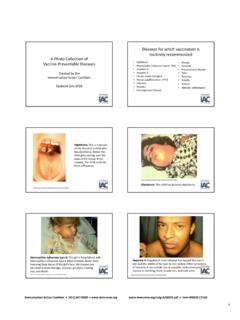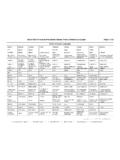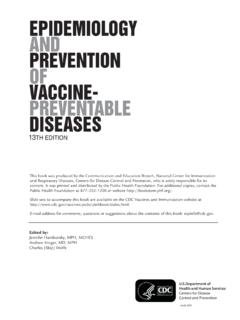Transcription of 2018 ASSESSMENT REPORT OF THE GLOBAL VACCINE …
1 GLOBAL VACCINE ACTION PLAN2018 ASSESSMENTREPORT OF THESTRATEGIC ADVISORYGROUP OFEXPERTS ONIMMUNIZATIONIMMUNIZATION TODAYAND IN THE NEXT DECADEWHO/ World Health Organization 2018 Some rights reserved. This work is available under the Creative Commons Attribution-NonCommercial-ShareAlike IGO licence (CC BY-NC-SA IGO; ). Under the terms of this licence, you may copy, redistribute and adapt the work for non-commercial purposes, provided the work is appropriately cited, as indicated below. In any use of this work, there should be no suggestion that WHO endorses any specific organization, products or services. The use of the WHO logo is not permitted. If you adapt the work, then you must license your work under the same or equivalent Creative Commons licence. If you create a translation of this work, you should add the following disclaimer along with the suggested citation: This translation was not created by the World Health Organization (WHO).
2 WHO is not responsible for the content or accuracy of this translation. The original English edition shall be the binding and authentic edition . Any mediation relating to disputes arising under the licence shall be conducted in accordance with the mediation rules of the World Intellectual Property citation. 2018 ASSESSMENT REPORT of the GLOBAL VACCINE Action Plan. Strategic Advisory Group of Experts on Immunization. Geneva: World Health Organization; 2018 (WHO/ ). Licence: CC BY-NC-SA (CIP) data. CIP data are available at , rights and licensing. To purchase WHO publications, see To submit requests for commercial use and queries on rights and licensing, see Third-party materials. If you wish to reuse material from this work that is attributed to a third party, such as tables, figures or images, it is your responsibility to determine whether permission is needed for that reuse and to obtain permission from the copyright holder.
3 The risk of claims resulting from infringement of any third-party-owned component in the work rests solely with the disclaimers. The designations employed and the presentation of the material in this publication do not imply the expression of any opinion whatsoever on the part of WHO concerning the legal status of any country, territory, city or area or of its authorities, or concerning the delimitation of its frontiers or boundaries. Dotted and dashed lines on maps represent approximate border lines for which there may not yet be full mention of specific companies or of certain manufacturers products does not imply that they are endorsed or recommended by WHO in preference to others of a similar nature that are not mentioned. Errors and omissions excepted, the names of proprietary products are distinguished by initial capital reasonable precautions have been taken by WHO to verify the information contained in this publication.
4 However, the published material is being distributed without warranty of any kind, either expressed or implied. The responsibility for the interpretation and use of the material lies with the reader. In no event shall WHO be liable for damages arising from its use. This publication contains the collective views of Strategic Advisory Group of Experts on Immunization and does not necessarily represent the decisions or the policies of by in VACCINE ACTION PLAN2018 ASSESSMENTREPORT OF THESTRATEGIC ADVISORYGROUP OFEXPERTS ONIMMUNIZATIONIMMUNIZATION TODAYAND IN THE NEXT DECADEGLOBAL VACCINE ACTION PLAN2018 ASSESSMENTREPORT OF THESTRATEGIC ADVISORYGROUP OFEXPERTS ONIMMUNIZATIONIMMUNIZATION TODAYAND IN THE NEXT DECADEiiiCONTENTS EXECUTIVE SUMMARY iv INTRODUCTION 1. HIGHLIGHTS OF THE YEAR 12. KEY INDICATORS 23. FRAGILE GAINS 54.
5 EQUITY 105. HUMANITARIAN EMERGENCIES 146. RESEARCH AND DEVELOPMENT 167. THE FUTURE 198. CONCLUSION 229. RECOMMENDATIONS 23 ANNEX 1: SAGE DECADE OF VACCINES WORKING GROUP MEMBERSHIP 24 ANNEX 2: SAGE MEMBERSHIP 25ivEXECUTIVE SUMMARYI mmunization has proven the test of time as one of public health s most cost-effective interventions. In 2017, the number of children immunized million was the highest ever reported. The Region of the Americas achieved maternal and neonatal tetanus elimination, leaving only 15 countries yet to achieve elimination. Since 2010, 113 countries have introduced new vaccines, and more than 20 million additional children have been vaccinated. Nevertheless, this year starkly illustrates how easily hard-won gains are lost. Because of low coverage nationally, or pockets of low coverage, multiple WHO regions have been hit with large measles and diphtheria outbreaks causing many deaths.
6 The continued detection of circulating VACCINE -derived poliovirus is further evidence that national immunization programmes are not achieving the goal of reaching every spur action, the GLOBAL VACCINE Action Plan set ambitious goals, and it remains the case that most targets will not be met by the end of the Decade of Vaccines in 2020. DTP3 and first-dose measles VACCINE coverage have plateaued globally at 85%. Progress towards the eradication of wild poliovirus and the elimination of measles, rubella, and maternal and neonatal tetanus is currently too slow to be achieved by the end of the picture provides a backdrop for discussions of the future of immunization after 2020, the final year of the Decade of Vaccines. The next decade is likely to be volatile and uncertain. Continuing mass urbanization and migration, population growth, geopolitical uncertainty and conflict, and natural disasters and environmental disruption will present major challenges to national immunization systems.
7 To meet these challenges, the immunization community must seek to maintain its hard-won gains but also aim to do more and to do things better, which may involve doing things differently. Equity must continue to be a strong driver, to ensure that everyone enjoys the benefits of immunization, including the most disadvantaged, marginalized and hard-to-reach populations, particularly those displaced or otherwise affected by natural disasters and conflict. Integration will be central to achieving future goals. Partnerships have been key to the successes of the GLOBAL VACCINE Action Plan, and will be critical to the future. Immunization is a central pillar of universal health coverage, providing an infrastructure on which effective and equitable health systems can be constructed. Through this integration, immunization can contribute to multiple Sustainable Development Goals as well as GLOBAL health security and the battle against antimicrobial will be at the heart of a future immunization strategy.
8 Regions will have a key role to play in supporting the development of national immunization systems, while GLOBAL immunization partners will continue working together to create an enabling environment for attention now turns to strengthening immunization post-2020, 2017 s outbreaks are a sobering reminder that no country can take its eye off the ball: effective national immunization systems require ongoing nurturing, political commitment and public support. All countries need to see immunization systems as core to their health systems, and all citizens need to see immunization as a basic human right. In their absence, countries, regions and the world as a whole are less healthy, less safe and less prosperous. We become complacent at our own saves an estimated 2 3 million lives every yearINTRODUCTION The GLOBAL VACCINE Action Plan, launched in 2011, set out goals and objectives for the immunization community for the decade to 2020.
9 Its vision was of a world in which all individuals and communities enjoy lives free from VACCINE -preventable diseases. The GLOBAL VACCINE Action Plan, developed by the immunization community and endorsed unanimously by the GLOBAL health community at the World Health Assembly (WHA), set ambitious goals and targets to catalyse a concerted GLOBAL drive to minimize the burden of VACCINE -preventable diseases in every country. GLOBAL immunization partners WHO, Gavi, the VACCINE Alliance, the Bill and Melinda Gates Foundation, UNICEF and the US National Institute of Allergy and Infectious Disease pledged to work together and with other immunization stakeholders to make this GLOBAL VACCINE Action Plan includes five goals and six strategic objectives. A set of specific indicators and targets was developed to support monitoring and evaluation, with progress reported annually through a comprehensive Secretariat REPORT and this summary ASSESSMENT REPORT .
10 Reporting on research and development (R&D) indicators takes place every two years, including this will never come a point at which immunization is no longer required. Every year, more than 130 million new babies are born each equally deserving of protection against VACCINE -preventable diseases. Exciting opportunities exist to extend the benefits of immunization to additional age groups, and to introduce new vaccines and VACCINE delivery technologies. Hence, as the Decade of Vaccines draws to a close, a new plan is needed to guide countries and immunization partners through the next decade. To ensure continuity, development of a new strategy needs to begin before the end of the Decade of Vaccines in 2020. Hence, as well as reviewing progress against GLOBAL VACCINE Action Plan targets and objectives, this ASSESSMENT REPORT also suggests a pathway towards the development of a post-2020 strategy, building on lessons learned during the Decade of Vaccines.
















